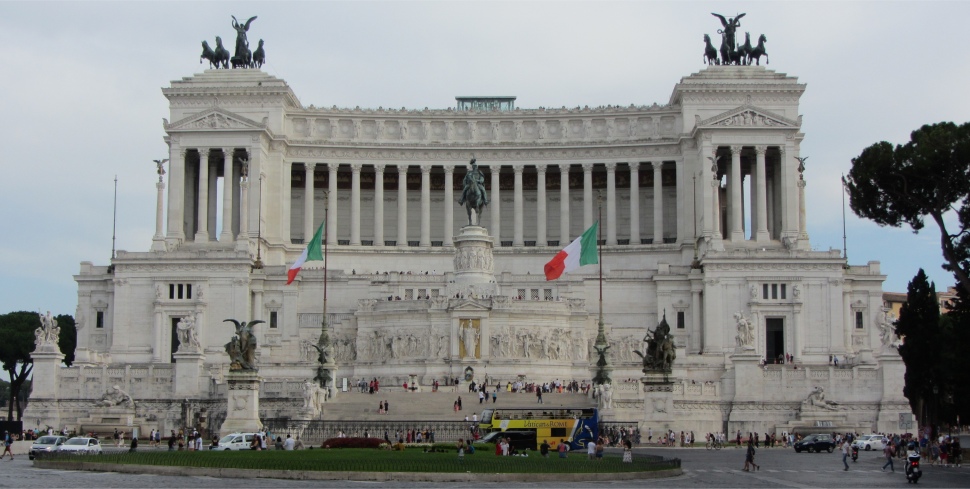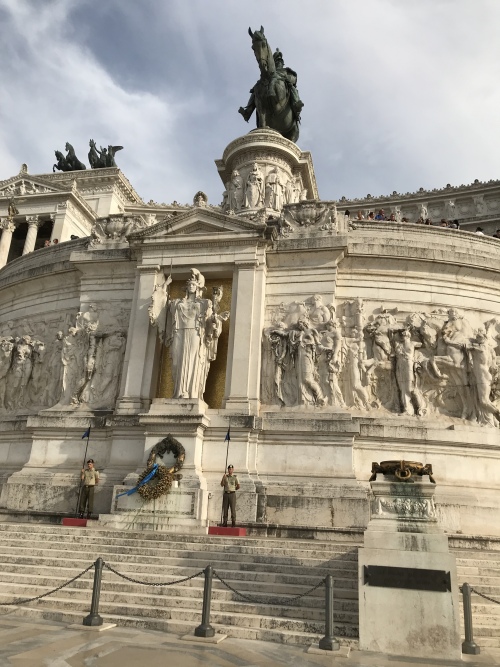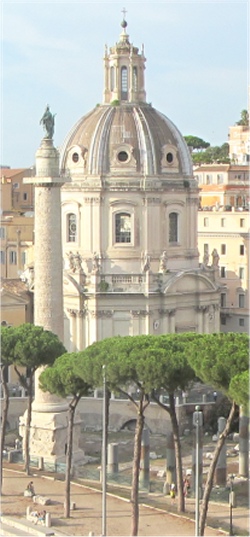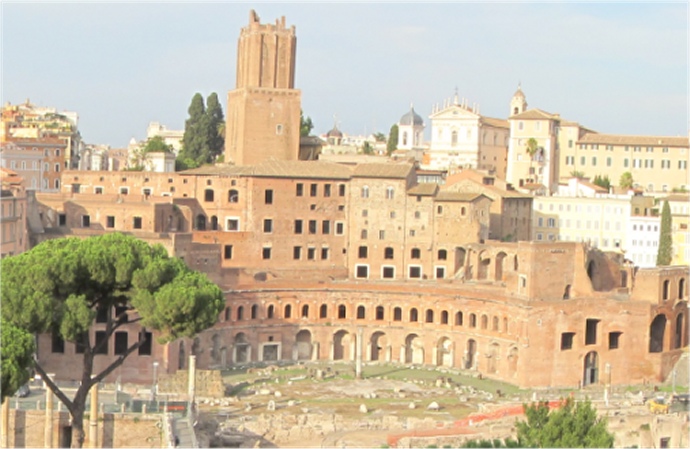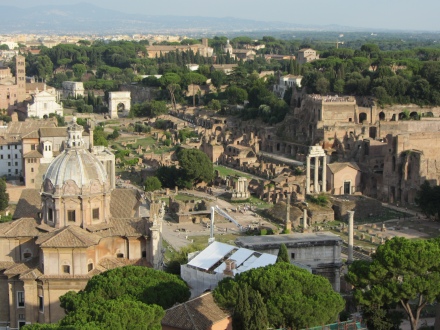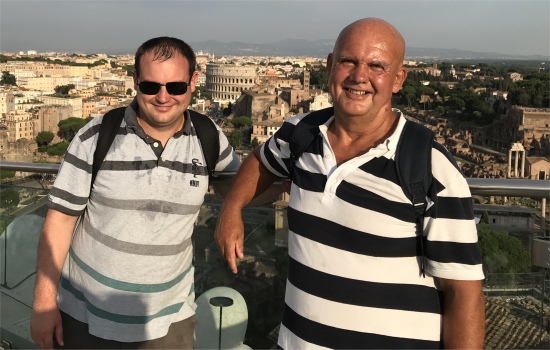 Galleria Borghese |
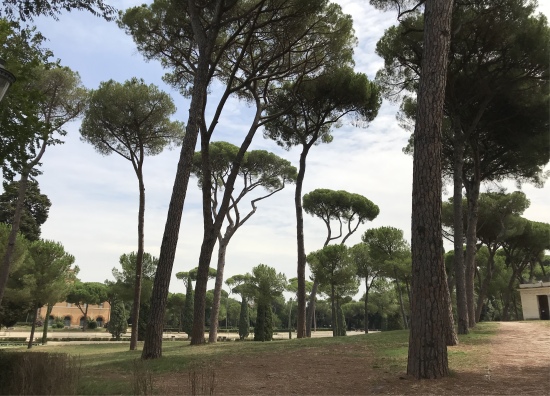 Grove of Trees between La Casina di Raffaello and Piazza di Siena |
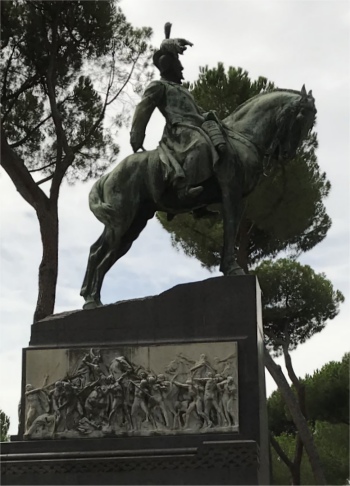 King Umberto I Monument |
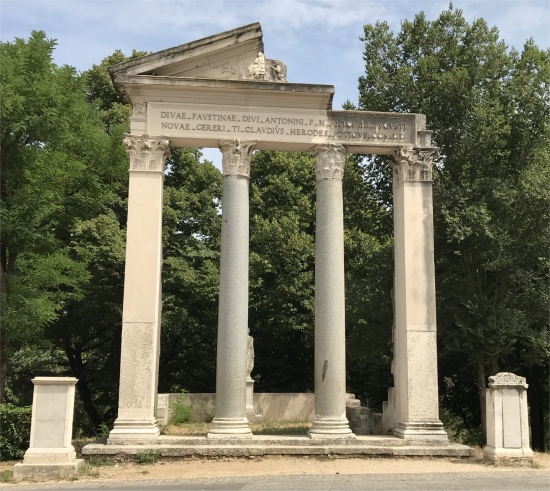 Temple of Antoninus and Faustina |
I learned that the "spokesman" was Alan, a bloke who had served with the REMI all his working life. He now lived in northern Germany and had German citizenship (probably married a German woman when he was based there). His two friends, Dave and Catherine, a married couple from Wales, had driven to Harwich, took the ferry across to the Hook of Holland, and drove across to where Alan lived. The three chums had travelled together over three days to Rome. So far they had seen most of the attractions in Rome, but would not be visiting Pompeii or Vesuvius.
The trio did not have a map, but I showed them how to use Google maps to obtain a walking route to the Trevi Fountain. We walked together for a short distance before our routes diverged. I hope they made it.
I hiked up through this delightful oasis to the Galleria, only to discover that the earliest time I could enter was 7pm. I should have booked! My, did I curse to myself. There was no way I was going to hang about for 8 hours. Instead, I took a leisurely stroll around the vast gardens, a green lung of the city.
The Villa Borghese Gardens are located on the Pincian Hill, close to Spanish Steps and Piazza del Popolo. The Gardens cover an area of 80 hectares and were developed in 1606 by Cardinal Scipione Borghese, who wanted to turn his former vineyard into the most extensive gardens built in Rome. In the same period, the Cardinal commissioned the building of the Villa Borghese Pinciana to the architect Flaminio Ponzio; today this elegant building houses the Galleria Borghese, The gardens were completely redesigned in the naturalistic English style in the 19th century and became a public park in 1903.
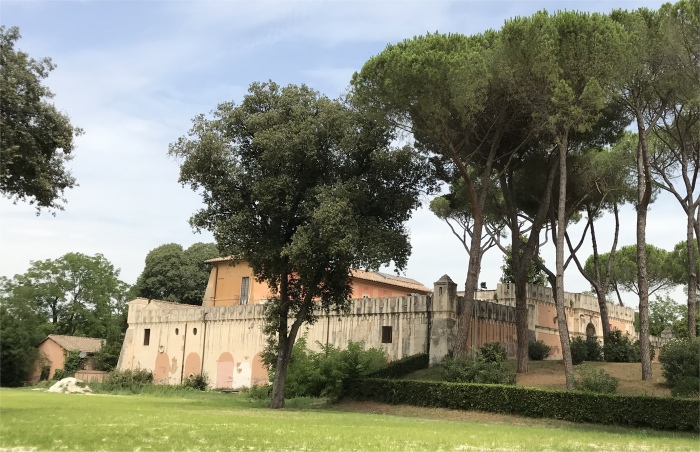 Pietro Canonica Museum |
A gang of kids charged out of the trees shouting and laughing, and disappeared down a slope on the other side of Viale dei Cavalli Marini. I turned to look where they had sprung from, and spotted an equestrian monument. I ambled over to it; in the fierce heat amble is the only word to use. The man mounted on the horse was King Umbert I, King of Italy from 9 January 1878 until his assassination on 29 July 1900. On April 21st, 1868, Umberto married his first cousin, Princess Margherita of Savoy (their fathers were brothers). According to legend, in 1889, the Margherita pizza, whose red tomatoes, green basil, and white cheese represent the Italian flag, was named after her. Umberto's reign saw Italy attempt colonial expansion into the Horn of Africa, successfully gaining Eritrea and Somalia despite being defeated by Abyssinia at the Battle of Adwa in 1896. In 1882, he approved the Triple Alliance with the German Empire and Austria-Hungary.
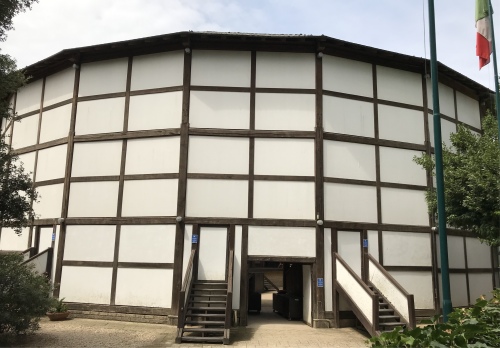 Globe Theatre |
I continued my way to the Temple of Antoninus and Faustina. Designed by Cristoforo Unterperger, the small temple was built in 1792, in the framework of the renovation commissioned by Marcantonio Borghese. It is composed of fragments of ancient architecture from the Roman Forum (Italians are masters of recycling old buildings), juxtaposed with modern parts to pretend a ruin, according to the fashion of English gardens. Behind the fašade, on a pedestal, is the ancient statue of Faustina. On the sides there are two areas with copies of the Greek inscriptions and the Latin metric version that decorated the entrance to the villa of Herod Atticus at the Caffarella.
Turning left towards the city, I came across the Pietro Canonica Museum which houses many works of art by this sculptor. The building, dating back to the 17th century, is known as Fortezzuola (small fortress), hosts the works by Pietro Canonica and the storage of Villa Borghese sculptures, displayed in the inner garden and in a room inside the museum. These sculptures originally decorated the paths and the buildings of the gardens, and were restored between the 16th - 19th centuries.
 Goethe Monument |
Strolling along Viale San Paolo del Brasile, I discovered a Monument to Goethe. The monument was made in Berlin from Carrara marble by the sculptor Valentino Casali on the model of Gustav Eberlein. It was donated to the city of Rome by the German Emperor William II, as a sign of the friendship between the Italians and Germans and in remembrance of the hospitality the city showed towards the poet. On 23rd June 1904, in the presence of King Victor Emanuel III, the monument dedicated to the great author and poet, Johann Wolfgang von Goethe (1749 - 1832), was inaugurated.
The statue of the poet alone is 3m high. He is represented at a young age at the time of arrival in Rome in 1786, dressed in an elegant suit with a cape on his left arm and a notebook in his right hand to recall the works written at Villa Borghese itself. Goethe is flanked by 3 groups of sculptures showing the main fields in which Goethe worked: drama, lyrical and philosophy. Goethe is shown as a young man at the time of arrival in Rome in 1786, with a notebook in his right hand to recall the works written at Villa Borghese itself. At the base of the statue are three groups of sculptures concerning three phases of Goethe's poetics, representing: Mignon and Lotario (left front), for lyric poetry; Ifigenia and Oreste (front right) for dramatic poetry; and Faust & Mephisto (back) for didactic poetry.
 Cinema dei Piccoli |
The slow meander around the gardens, interspersed with the occasional coffee, was the perfect tonic to the last few days of tourist cramming. I had thoroughly enjoyed the time out - if I had managed to get into the Galleria I might have missed that delightful time in the gardens.
But the time had come for me to do something productive. I headed back down into the city to purchase some presents for my grandchildren - always a daunting task that takes ages. I made it easier on myself by deciding up front to buy items that they could wear.
With that mammoth task accomplished, I took refuge under the awning of a bar in Piazza di Pietra overlooking the Temple of Hadrian. A cool beer and Macedonia (fruit salad) provided me with sustenance.
Numerous guided tours passed by, pausing to gaze at the temple before moving on. One elderly gent slowly walked out of a side street, a little flag on a stick limply waving about above his head marked him down as a tour guide. He slowly shuffled across the piazza, but where were his flock? About 40 seconds later they appeared from the same side street, ambling at the same pace, bored and reduced to a twitching, trickle of sweat.
 Temple of Hadrian |
Several times we had spotted a tall, white, marbled building with two horse drawn chariots straddling its top. We decided to investigate, and so we hiked to Piazza Venezia where it is located. This piazza is a major road junction in the city, located where four major roads meet. On one side you can look down Rome's longest street, the Via del Corso to the ancient northern gates of the city by Piazza del Popolo. This street was named for the 15th century "corsa dei barberi" or "race of the barbarians" - a tradition at Carnival of racing horses down the 1.5km street, but it's origins date back to ancient Rome. Today, Rome's longest, straightest street is best known for shopping. From another angle, the ruins of the Imperial Forums lead the way to the Colosseum. Take a different road and you'll end up in the Jewish Ghetto, on your way to Rome's Trastevere neighbourhood and last but not least, towering over the piazza, is the unmissable marble monument: Il Vittoriano.


